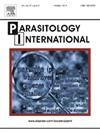Zinc pyrithione inhibits blood-stage parasites of Plasmodium falciparum and its combinatorial effect with dihydro-artemisinin and chloroquine in culture
IF 1.9
4区 医学
Q3 PARASITOLOGY
引用次数: 0
Abstract
The malarial parasite Plasmodium falciparum has evolved resistance to several antimalarial drugs, posing a significant challenge to the effective management and treatment of malaria in endemic areas. Drug repurposing has emerged as a potential alternative strategy for addressing this issue. This study aimed to identify an FDA-approved microbicidal agent, zinc pyrithione (ZPT), against mixed blood-stage parasites of P. falciparum chloroquine-sensitive (Pf3D7) and resistant strains (PfINDO). Based on the time-inhibition kinetics assay, the parasite viability was significantly inhibited by ZPT treatment for 96 h (0.77 μM and 0.37 μM) and 72 h (0.63 μM and 0.61 μM), followed by 48 h (0.76 μM and 1.32 μM) and moderate inhibitory effects for 12 and 24 h in both Pf3D7 and PfINDO culture. Stage-specific treatment revealed that trophozoites and schizonts exposed to ZPT were more susceptible than ring-stage parasites. Phenotypic assays revealed that trophozoites and schizonts failed to mature and exhibited aberrant morphologies such as condensed nuclei, as determined by Giemsa staining. Furthermore, ZPT in combination with dihydro-artemisinin and chloroquine demonstrated additive interactions in both Pf3D7 and PfINDO parasites. At therapeutic dosages, ZPT failed to cause hemolysis in human erythrocytes. Overall, this study demonstrated a time-dependent effect of ZPT on the blood stages of human P. falciparum in culture, suggesting its utility in clinical settings.
吡硫锌对恶性疟原虫血期寄生虫的抑制作用及其与双氢青蒿素和氯喹的联合培养效果。
疟疾寄生虫恶性疟原虫已经进化出对几种抗疟药物的耐药性,对疟疾流行地区的有效管理和治疗构成重大挑战。药物再利用已成为解决这一问题的潜在替代战略。本研究旨在鉴定一种经fda批准的杀灭恶性疟原虫氯喹敏感菌株(Pf3D7)和耐药菌株(PfINDO)混合血期寄生虫的杀微生物剂吡硫锌(ZPT)。time-inhibition动力学分析的基础上,这种寄生虫生存能力被显著地抑制ZPT治疗96(0.77 μM和0.37μM)和72年 h(0.63 μM和0.61μM),其次是48 h(0.76 μM和1.32μM)和温和的抑制效果为12和24 h Pf3D7和PfINDO文化。阶段特异性处理表明,暴露于ZPT的滋养体和分裂体比环期寄生虫更敏感。表型分析显示,滋养体和分裂体未能成熟,并表现出异常的形态,如凝聚核,由吉姆萨染色确定。此外,ZPT与双氢青蒿素和氯喹联合在Pf3D7和PfINDO寄生虫中均表现出加性相互作用。在治疗剂量下,ZPT不能引起人红细胞溶血。总的来说,这项研究证明了ZPT对培养的人类恶性疟原虫血液阶段的时间依赖性作用,表明其在临床环境中的实用性。
本文章由计算机程序翻译,如有差异,请以英文原文为准。
求助全文
约1分钟内获得全文
求助全文
来源期刊

Parasitology International
医学-寄生虫学
CiteScore
4.00
自引率
10.50%
发文量
140
审稿时长
61 days
期刊介绍:
Parasitology International provides a medium for rapid, carefully reviewed publications in the field of human and animal parasitology. Original papers, rapid communications, and original case reports from all geographical areas and covering all parasitological disciplines, including structure, immunology, cell biology, biochemistry, molecular biology, and systematics, may be submitted. Reviews on recent developments are invited regularly, but suggestions in this respect are welcome. Letters to the Editor commenting on any aspect of the Journal are also welcome.
 求助内容:
求助内容: 应助结果提醒方式:
应助结果提醒方式:


